Missile defense of Moscow. Part I
System "A"
The work on the new project was assigned to a specially created SKB-30, separated from the SB-1, which created the C-25 air defense system. G.V. was appointed head of the new design office. Kisunko. The project under the letter "A" was intended to determine the technical appearance and the overall architecture of the promising anti-missile system. It was assumed that the system "A" will be built on the site and will not go beyond it. The project was intended only for working out common ideas and technologies.
The structure of the experimental complex should have included several tools designed to detect and destroy targets, as well as to process information and control all systems. PRO "A" consisted of the following components:
- Radar station "Danube-2", designed to detect ballistic missiles at a distance of 1200 kilometers. The development of this radar was engaged in scientific research institute-37;
- Three precision-guided radars (PTH), incorporating separate radars for tracking the target and antimissile. RTN was developed in SKB-30;
- Radar output antimissiles and missile control station combined with it. Created in SKB-30;
- Anti-missiles B-1000 and starting positions for them;
- The main command-computing point of the missile defense system;
- Means of communication between the various elements of the complex.
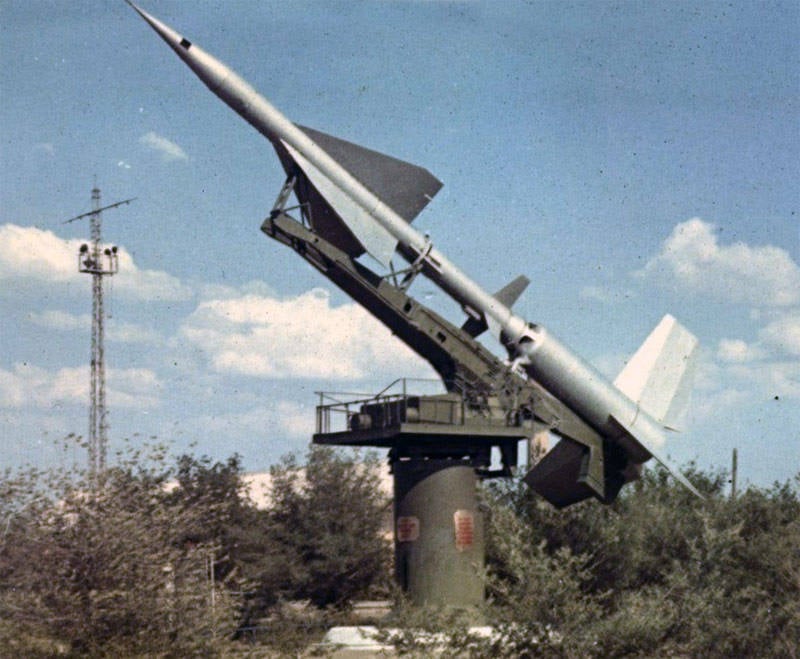
Monument to the B-1000 rocket on the standard PU SM-71P in the town of Priozersk, Sary-Shagan test site (http://militaryrussia.ru/forum)
For the detection of targets - ballistic missiles or their combat units - the radar station "Danube-2" was to be used. The station had two separate radars, which were built on the shores of Lake Balkhash at the “A” range (Sary-Shagan). It should be noted that the radar "Danube-2" on the tests showed higher performance than originally planned. In March, the station 1961 discovered a training target (ballistic missile Р-12) at a distance of 1500 km, immediately after it appeared above the radio horizon.
Accompanying missiles was proposed to carry out the method of "three ranges." According to calculations G.V. Kisunko, three radars could provide the definition of the coordinates of the target with an accuracy of 5 meters. The construction of a precision guidance radar system began with calculations on paper. The first step in this case was a circle on the map with a regular triangle inscribed into it, the sides of which had a length of 150 km. In the corners of the triangle was proposed to place the station RTN. The center of the circle is designated as T-1. Not far from it was the point T-2 - the estimated location of the fall of the warhead conditional target. In 50 kilometers from the point T-2 offered to place the starting position of missile interceptors. In accordance with this scheme, construction of various “A” system objects began near Lake Balkhash.
To destroy ballistic targets, it was proposed to develop a V-1000 interceptor missile with the corresponding characteristics. OKB-2 of the Ministry took up the development of ammunition aviation industry (now MKB "Fakel"). The work was directed by P.D. Grushin. The rocket was decided to build on a two-stage scheme. The first stage was supposed to have a solid fuel starting engine, the second - liquid, developed under the guidance of A.M. Isaeva. With such a power plant, the V-1000 missile could fly at a speed of up to 1000 m / s and intercept targets at ranges up to 25 kilometers. The maximum flight range is 60 km. A missile could carry a fragmentation or nuclear warhead weighing 500 kg. The length of the ammunition was 14,5 meters, the starting weight was 8785 kg.
Especially for the B-1000 was developed by the original warhead, designed to increase the likelihood of destruction of the target with one missile. The warhead was equipped with 16 with thousands of tiny attack elements and an explosive charge for their release. It was assumed that when approaching the target, a scattering charge would be undermined and damage would be released. Because of their design, the latter received the nickname "nuts in chocolate." Each such “nut” with a diameter of 24 mm had an 10-mm spherical tungsten carbide core coated with an explosive. Outside there was a steel shell. The striking elements were to converge with a goal at a speed of at least 4-4,5 km / s. At such a speed, contact between the elements and the target led to the explosion of the explosive and damage to the object under attack. An additional destructive effect had a solid core. The warhead of the intercepted rocket, having been damaged, had to collapse under the action of air flow and high temperature.
It was assumed to direct the rocket using the RTN. The interception was to take place with a parallel approach to the goal on a collision course. The ground automatics of the “A” system was to determine the trajectory of the target and lead the interceptor missile to the closest point accordingly.
The construction of all elements of the “A” system at the test site in Kazakhstan continued until the autumn of 1960. After testing various systems, trials were launched with the interception of conditional targets. For some time, the training targets for the antimissile system have been the P-5 ballistic missiles. 24 November 1960, the first test interception. The B-1000 anti-missile, equipped with a warhead weight simulator, successfully approached a target a distance sufficient to destroy it.
The following tests were less successful. Within a few months, several interceptor missiles had been incurred to no avail. For example, when launching 31 in December 1960 of the year, target tracking stopped due to system problems. 13 January 61-th failure occurred due to failure of the airborne transponder of the missile. However, the following four launches of B-1000 interceptors on P-5 missiles were successful.
4 March 1961, the first launch of the rocket B-1000 with a regular warhead equipped with "nuts in chocolate." A ballistic missile P-12 was used as a training target. The P-12 rocket with a weight imitator of the warhead took off from the launch position at the Kapustin Yar launch site and headed towards the “A” test site. Radar "Danube-2", as already mentioned, was able to detect the target at a distance of 1500 kilometers, immediately after its appearance over the radio horizon. The ballistic missile was destroyed at an altitude of about 25 kilometers inside the triangle formed by precision guidance radars.
26 of March of the same year the following tests of the “A” system were carried out, in which the P-12 ballistic missile with a standard high-explosive warhead was used. The target was destroyed at high altitude. Later on, 10 test interceptions of ballistic missiles were made. In addition, from 1961 to 1963 years, the B-1000 rocket variant with an infrared homing head was tested at the “A” test site. The system, developed at the Leningrad State Optical Institute, was intended to improve the accuracy of targeting anti-missiles at the target. In 1961, the test launches of the B-1000 rocket with a nuclear warhead not equipped with fissile material were conducted.
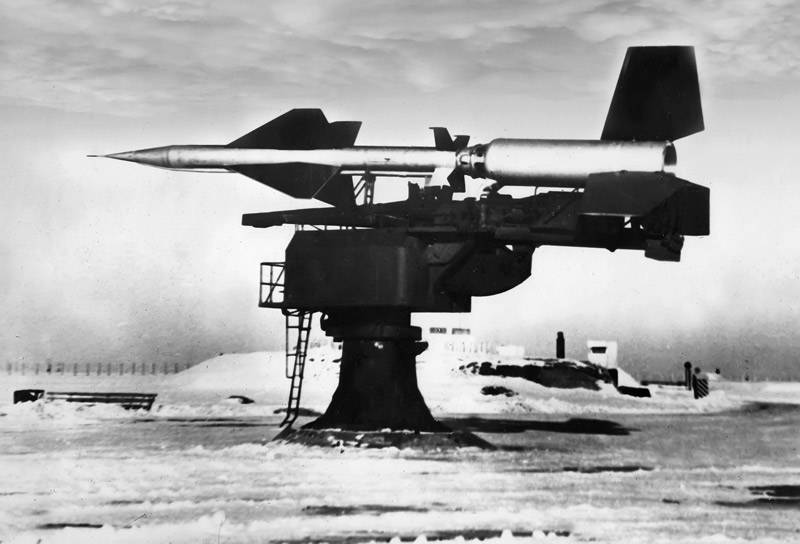
The anti-missile B-1000 on the PU SM-71P (http://vpk-news.ru)
By the middle of 1961, the project “System“ A ”” reached its logical end. Tests have shown the advantages and disadvantages of the applied solutions, as well as the potential of the entire anti-missile system. Using the experience gained, a preliminary design of a prospective missile defense system was created, which was to be used to protect important objects.
A-35 Aldan
In June, the SKN-1961 30 of the year completed work on the draft design of a full-fledged antimissile defense system called A-35 Aldan. It was assumed that a promising missile defense system will be able to fight with American ballistic missiles of the Titan and Minuteman families.
To ensure the protection of Moscow, it was proposed to include the following components in the А-35 system:
- command post with the means of collecting and processing information, as well as the management of all other means;
- 8 radar stations “Danube-3” and “Danube-3U”. The review sectors of these radars were supposed to overlap, forming a continuous circular field;
- 32 shooting complex with launchers and missiles.
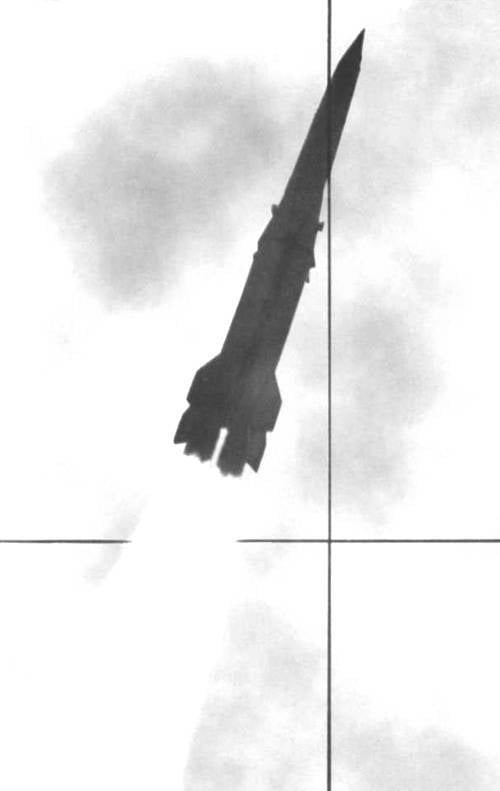
Launch of the early version of the 5ВХNUMX / А-61Ж / ABM-350 GALOSH rocket with ailerons with gas-dynamic engines (Korovin V., Fakel missiles. M., MKB Fakel, 1)
The defense of this version of the project took place in the autumn of 1962. However, in the future, the architecture of the anti-missile system A-35 has changed significantly. Thus, it was proposed to reduce the number of firing complexes by half (to 16), and also to equip the interceptor missile with a nuclear warhead, not a high-explosive fragmentation bomb. Soon there were new proposals that led to another change in the appearance of the entire system. The final composition of the complex A-35 looked like this:
- The main command-computing center (GKVTS) with the main command center and computer 5E92B. The latter was a dual-processor system based on discrete semiconductor circuits and was designed to process all incoming information;
- Radar early warning system based on the radar "Danube-3" and "Danube-3";
- 8 firing systems. The complex included a command post, one radar of the target channel of the RCC-35, two radars of the anti-missile channel RCT-35, and two firing positions with four launchers each;
- A-350Zh anti-missiles with transport and launch containers.
The A-350Zh interceptor missile had a length of 19,8 m and a starting weight of 29,7 tons (the missiles of the later series grew heavier to 32-33 tons). The rocket was built on a two-stage scheme and was equipped with liquid engines. The first stage had four engines, the second one. For maneuvering the second stage was equipped with gas and aerodynamic control surfaces. The second stage was carrying a warhead weighing 700 kg. According to reports, the A-350J rocket could destroy ballistic targets at altitudes from 50 to 400 kilometers. The maximum target speed is 5 km / s. The rocket was delivered to the position in the transport and launch container from which the launch was made.
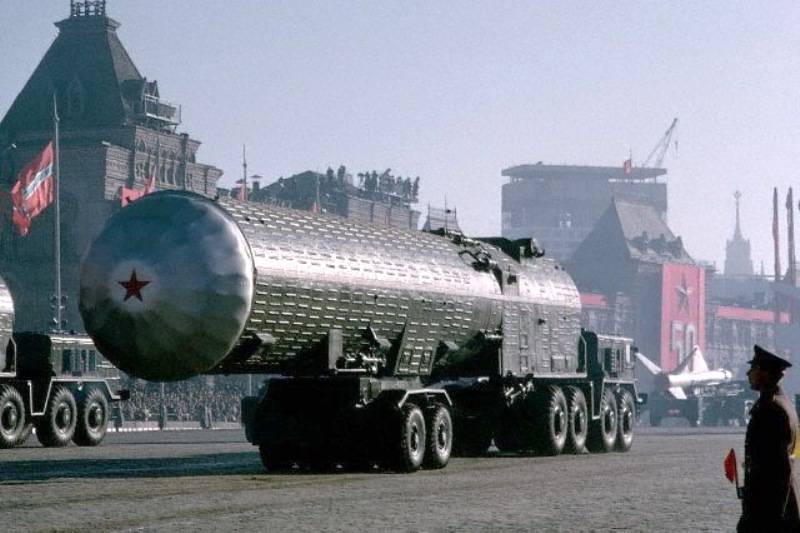
Transport vehicle on MAZ-537 chassis with TPK with 5В61 / А-350Ж rocket model at Parade in Moscow 7 November 1967 (photo from Marc Garanger archive, http://militaryphotos.net)
It was proposed to launch the missile according to the “three-range” method. The automatic control of the missile made it possible to direct ammunition at the target, and also to retarget it in flight, after identifying false targets. Interestingly, initially to determine the coordinates of the target and antimissiles it was proposed to use three or four radar stations. However, for a simultaneous attack of the required number of targets, several hundred radars would have to be included in the Aldan system. In this regard, it was decided to use the definition of the coordinates of the target using one station. The reduction in accuracy was proposed to be compensated for by the power of the anti-missile warhead.
The initial detection of targets was assigned to the radar stations "Danube-3" and "Danube-3M". The Danube-3 decimeter station and the Danube-3M meter station were to be located around Moscow and provide all-round visibility. The capabilities of these stations made it possible to simultaneously track up to 1500-3000 of various types of ballistic targets. A prototype of the Danube-3 station was built at the Sary-Shagan test site on the basis of the existing Danube-2 radar, which was intended for the experimental project "A".
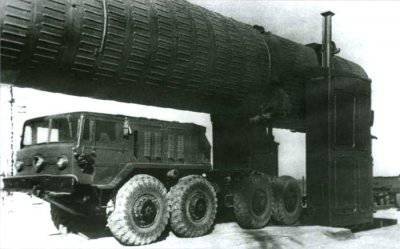
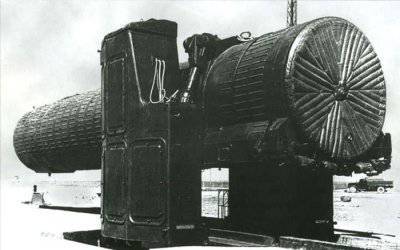
A series of shots of a transport vehicle with a different type of container with the 5B61 / A-350Ж rocket. TPK installation on the starting. Ground Launcher, Sary-Shagan (Korovin V., Missiles "Torch". M., ICD "Torch", 2003 g.)
The radar channel channel targets RCC-35 intended for tracking purposes: the warhead of a ballistic missile and its last stage. This station was equipped with an antenna with a diameter of 18 meters, all units were covered with a radio transparent cover. RCC-35 station could simultaneously accompany two targets, capturing them at a distance of up to 1500 kilometers. Radar channel antimissile RCT-35 was designed to monitor and control the missile. This station had two antennas. Small, with a diameter of 1,5 meter, was intended to bring the interceptor missile to the trajectory. Another antenna, with a diameter of 8 m, was used to guide the anti-missile. One RCC-35 station could simultaneously direct two anti-missiles.
In the mid-sixties, construction began on the A-35 Aldan system near Moscow, as well as at the Sary-Shagan test site. An experimental complex at the site was built in a reduced configuration. It consists of a simplified version of the GKVTS, one radar "Danube-3" and three firing complexes. Tests of the polygon missile defense system started in 1967 year. The first stage of testing continued until the 1971 year, after which the second part started. It should be noted that the tests of the A-350J rocket began in the 1962 year.
Prior to 1971, the A-35 system was tested using A-350J missiles. The A-350J and A-350Р missiles were used in the tests of the second stage. Various tests of the Aldan complex elements continued until the 1980 year. A total of about 200 anti-missile launches were conducted. The interception of ballistic missiles of various types. Landfill complex A-35 was used until the end of the eighties, i.e. until the end of the service of the combat system around Moscow.
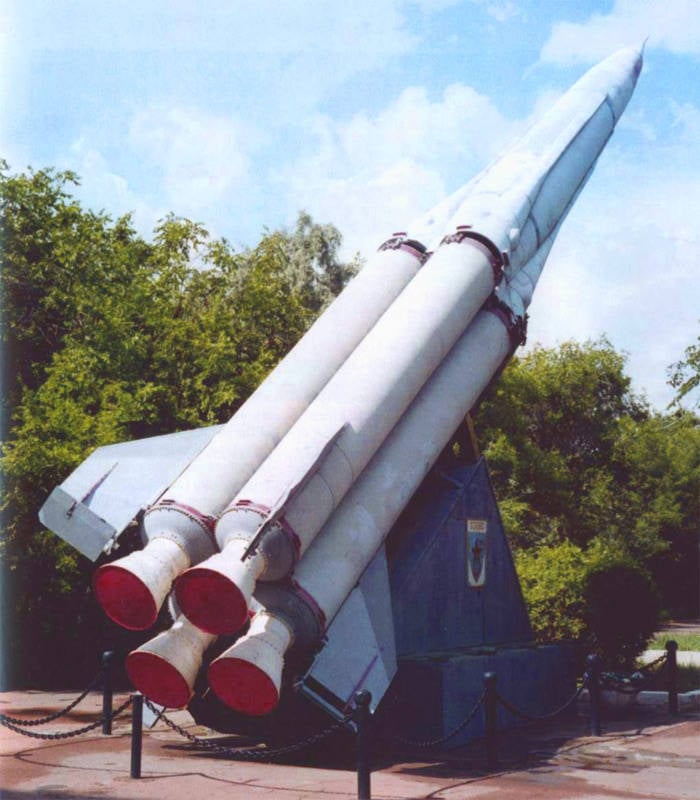
Monument to the A-350 rocket in the city of Pryozersk (V. Korovin, Torch Missiles. Moscow, Torch ICD, 2003)
The construction of the A-35 anti-missile system Aldan in the Moscow region began in the early sixties, but the deployment of various elements of the complex began only in 1967-68. It was originally intended to deploy 18 firing systems with eight launchers each (4 missiles for the first and re-launch). In total, the 144 A-350J missiles should be on duty. In the summer of 1971, the first phase of the А-35 system was put into service. 1 September she put on combat duty.
The construction of the A-35 system was completed in the summer of 1973. By this time, two radar detection systems "Danube-3" and "Danube-3M", as well as four positional areas with 64 launchers ready to launch missiles, were built. In addition, a main command-computing center was built in Kubinka, and a missile training base began operating in Balabanovo. All elements of the anti-missile complex were connected using the Kabel data transmission system. Such a composition of the antimissile system made it possible to simultaneously attack up to eight paired (warhead and final stage corps) targets flying from different directions.
A-35M
From 1973 to 1977, the developers of the A-35 system worked on a project to upgrade it. The main objective of this work was to ensure the possibility of the destruction of complex targets. It was necessary to ensure the effective defeat of warheads of ballistic missiles, "protected" by light and heavy false targets. There were two suggestions. According to the first, it was necessary to modernize the existing A-35 system, and the second implied the development of a new complex. As a result of a comparison of the presented calculations, it was decided to update the Moscow missile defense system in accordance with the first proposal. Thus, it was necessary to update and improve the anti-missile system A-35, which are responsible for processing information, defining and tracking targets, and creating a new rocket.
In 1975, the project management changed. Instead of G.V. I.D. Kisunko became the head of the antimissile program. Omelchenko. In addition, the head organization of the program was the Vympel Central Research and Production Association, founded in 1970. It was this organization that conducted further work, presented a modernized missile defense system for testing, and carried out its further support.
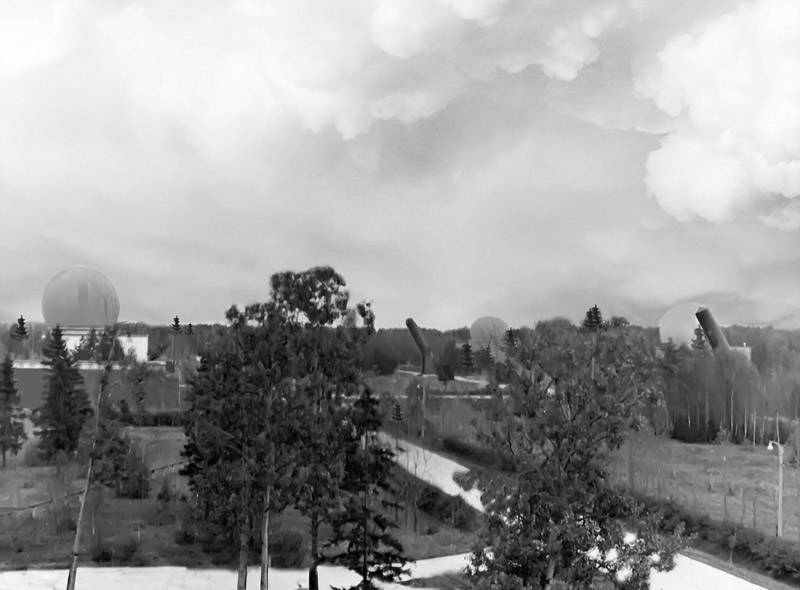
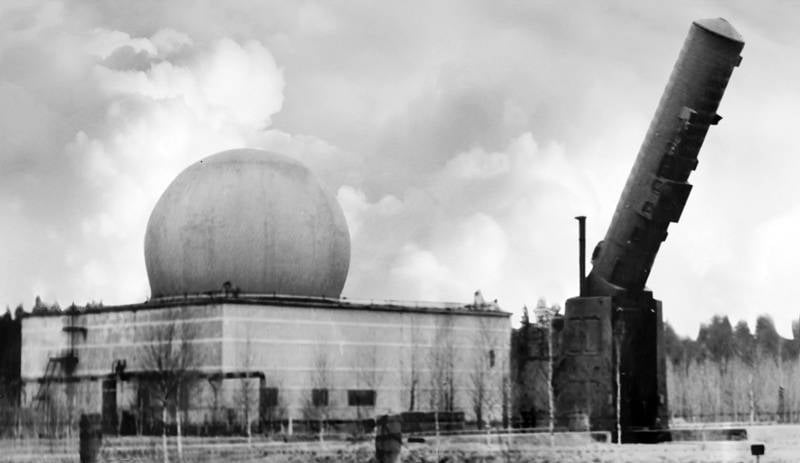
Position area of А-35М system with Tobol firing complexes (above) and А-350Ж anti-missile launchers near the A-35М РКИ-35 radar. Presumably the top image is a photomontage. (http://vpk-news.ru)
The composition of the upgraded anti-missile system, designated A-35M, differed little from that of the Aldan base complex. Its various elements were modernized. System A-35M consisted of the following components:
- The main command-computing center with modified computers. To perform new tasks, a new algorithm was developed for processing information from the radar and transmitting commands. Virtually all radars were assembled into a single detection and tracking system;
- Radar "Danube-3M" and "Danube-3U". The latter has undergone upgrades related to the plans of the likely enemy. After updating its characteristics, it was possible to monitor the territory of the Federal Republic of Germany, where the United States was going to deploy its medium-range ballistic missiles;
- Two shooting complex with new mine launchers. Each complex had 8 launchers and 16 A-350ZH or A-350Р launchers, as well as one guidance radar. The other two firing systems of the А-35 system were mothballed before further modernization. According to some reports, the modernization of these complexes was carried out over the next few years, so that the number of antimissiles on duty remained the same (64 units);
- A-350P interceptor missile. From the previous anti-missile A-350ZH it differed in the use of new control systems and other equipment. For example, the equipment was highly resistant to radiation.
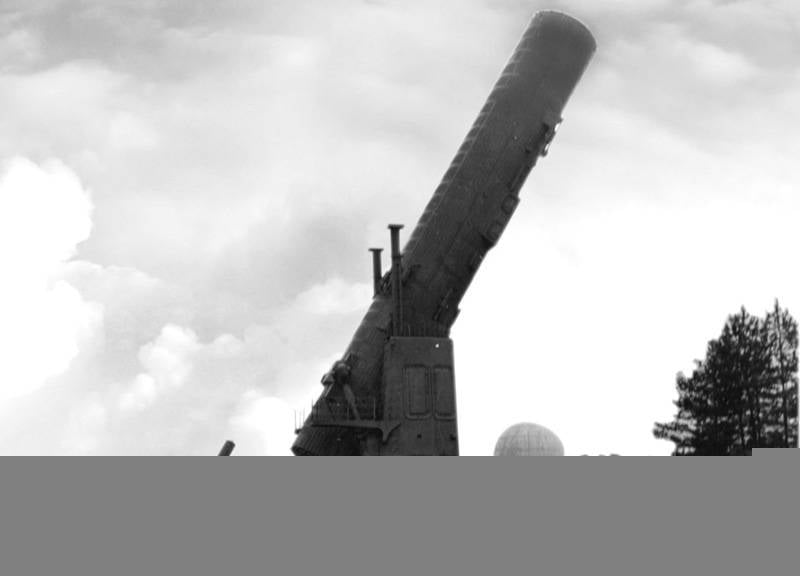
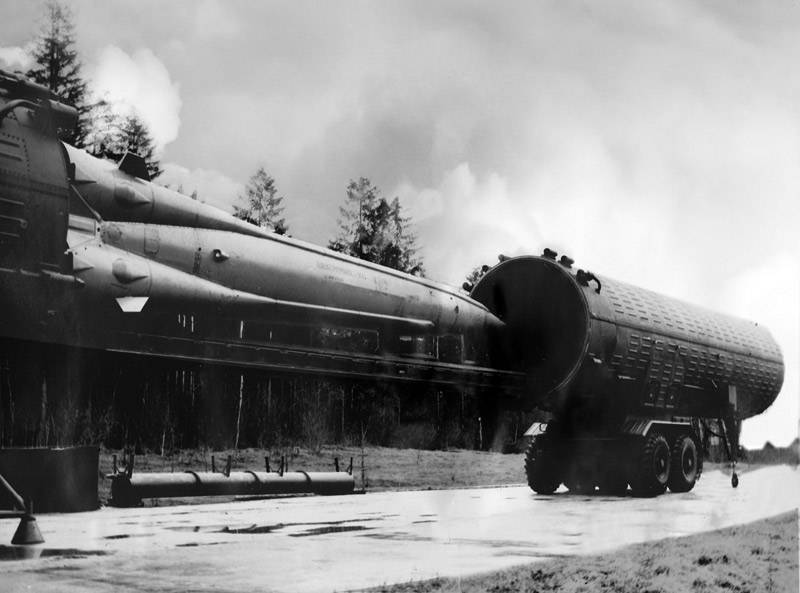
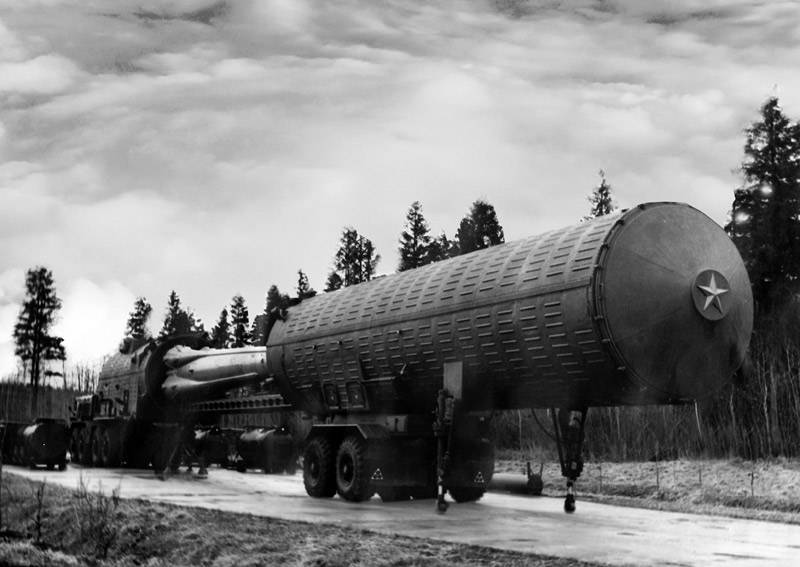
The launcher of the complex "Tobol" and equipment TPK 5P81 rocket A-350ZH (http://vpk-news.ru)
In May 1977, the A-35M system was presented for testing. The inspection of the systems lasted for several months, after which it was decided to adopt the new complex. Operation of the missile defense system continued until the end of the eighties. According to some information, in the spring of 1988, a fire occurred at the command post of the system, due to which it lost some functions. Nevertheless, the radar stations continued to work, simulating the full-fledged functioning of the anti-missile system. In December 1990, the A-35M system was removed from service. Some of the elements of the system were dismantled, but one of the Danube-3U radar continued to be operated as part of a missile attack warning system until at least the middle of the last decade.
On the materials of the sites:
http://pvo.guns.ru/
http://priozersk.com/
http://old.vko.ru/
http://militaryparitet.com/
http://popmech.ru/
http://militaryrussia.ru/blog/topic-344.html

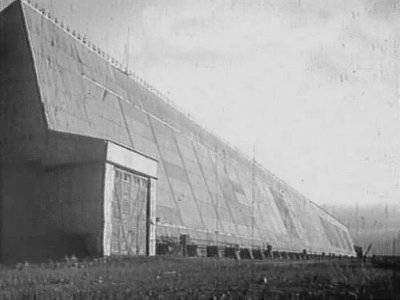
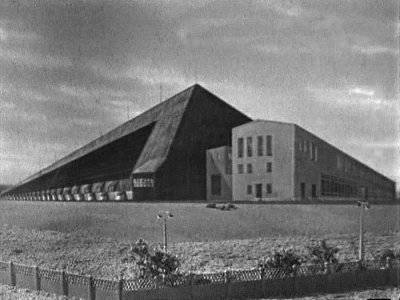
Information